英语修辞法梳理
- 格式:doc
- 大小:71.00 KB
- 文档页数:12
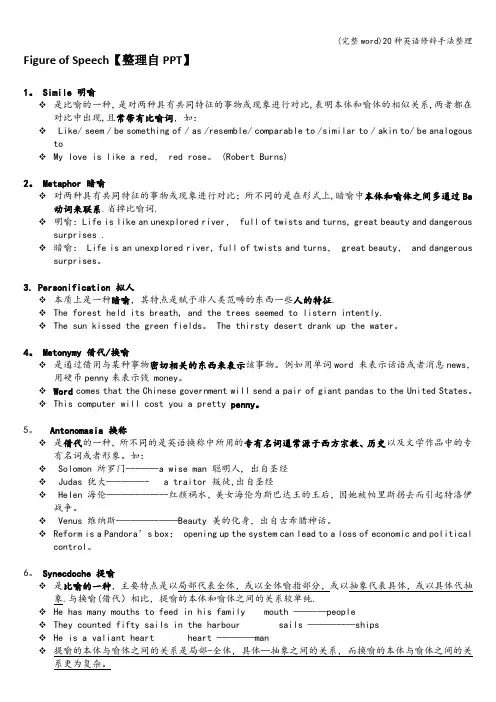
Figure of Speech【整理自PPT】1。
Simile 明喻❖是比喻的一种,是对两种具有共同特征的事物或现象进行对比,表明本体和喻体的相似关系,两者都在对比中出现,且常带有比喻词,如:❖ Like/ seem / be something of / as /resemble/ comparable to /similar to / akin to/ be analogous to❖My love is like a red, red rose。
(Robert Burns)2。
Metaphor 暗喻❖对两种具有共同特征的事物或现象进行对比;所不同的是在形式上,暗喻中本体和喻体之间多通过Be 动词来联系.省掉比喻词.❖明喻:Life is like an unexplored river, full of twists and turns, great beauty and dangerous surprises .❖暗喻: Life is an unexplored river, full of twists and turns, great beauty, and dangerous surprises。
3. Personification 拟人❖本质上是一种暗喻,其特点是赋予非人类范畴的东西一些人的特征.❖The forest held its breath, and the trees seemed to listern intently.❖The sun kissed the green fields。
The thirsty desert drank up the water。
4。
Metonymy 借代/换喻❖是通过借用与某种事物密切相关的东西来表示该事物。
例如用单词word 来表示话语或者消息news,用硬币penny来表示钱 money。
❖Word comes that the Chinese government will send a pair of giant pandas to the United States。
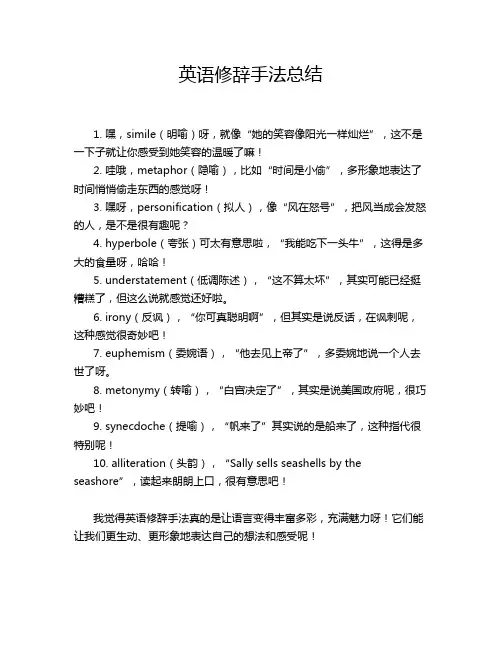
英语修辞手法总结
1. 嘿,simile(明喻)呀,就像“她的笑容像阳光一样灿烂”,这不是一下子就让你感受到她笑容的温暖了嘛!
2. 哇哦,metaphor(隐喻),比如“时间是小偷”,多形象地表达了时间悄悄偷走东西的感觉呀!
3. 嘿呀,personification(拟人),像“风在怒号”,把风当成会发怒的人,是不是很有趣呢?
4. hyperbole(夸张)可太有意思啦,“我能吃下一头牛”,这得是多大的食量呀,哈哈!
5. understatement(低调陈述),“这不算太坏”,其实可能已经挺糟糕了,但这么说就感觉还好啦。
6. irony(反讽),“你可真聪明啊”,但其实是说反话,在讽刺呢,这种感觉很奇妙吧!
7. euphemism(委婉语),“他去见上帝了”,多委婉地说一个人去世了呀。
8. metonymy(转喻),“白宫决定了”,其实是说美国政府呢,很巧妙吧!
9. synecdoche(提喻),“帆来了”其实说的是船来了,这种指代很特别呢!
10. alliteration(头韵),“Sally sells seashells by the seashore”,读起来朗朗上口,很有意思吧!
我觉得英语修辞手法真的是让语言变得丰富多彩,充满魅力呀!它们能让我们更生动、更形象地表达自己的想法和感受呢!。
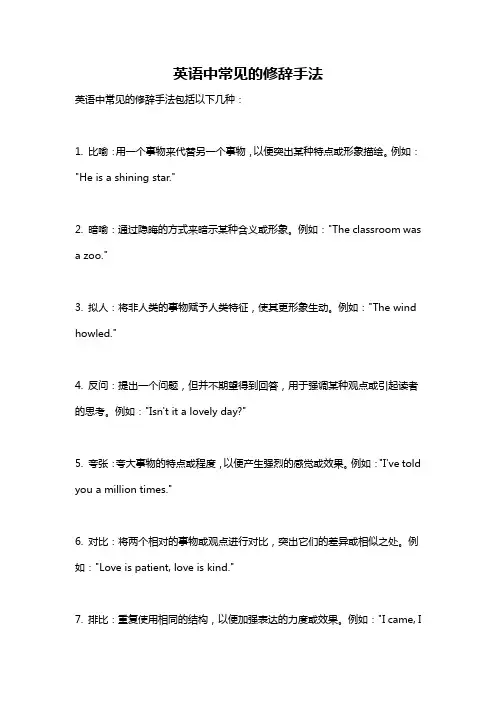
英语中常见的修辞手法英语中常见的修辞手法包括以下几种:1. 比喻:用一个事物来代替另一个事物,以便突出某种特点或形象描绘。
例如:"He is a shining star."2. 暗喻:通过隐晦的方式来暗示某种含义或形象。
例如:"The classroom wasa zoo."3. 拟人:将非人类的事物赋予人类特征,使其更形象生动。
例如:"The wind howled."4. 反问:提出一个问题,但并不期望得到回答,用于强调某种观点或引起读者的思考。
例如:"Isn't it a lovely day?"5. 夸张:夸大事物的特点或程度,以便产生强烈的感觉或效果。
例如:"I've told you a million times."6. 对比:将两个相对的事物或观点进行对比,突出它们的差异或相似之处。
例如:"Love is patient, love is kind."7. 排比:重复使用相同的结构,以便加强表达的力度或效果。
例如:"I came, Isaw, I conquered."8. 修饰语:使用形容词、副词等修饰词语,以增强其描述能力或表达感情色彩。
例如:"The sun was shining brightly."9. 双关语:使用具有多重意义的词语或短语,以产生幽默效果或引起读者的注意。
例如:"Time flies like an arrow; fruit flies like a banana."10. 反复:重复使用相同的词语或短语,以强调某种观点或产生连贯的效果。
例如:"Never, never, never give up."这些修辞手法在语言表达中起到了丰富和强调的作用,并可以提升语言的美感和表达的效果。
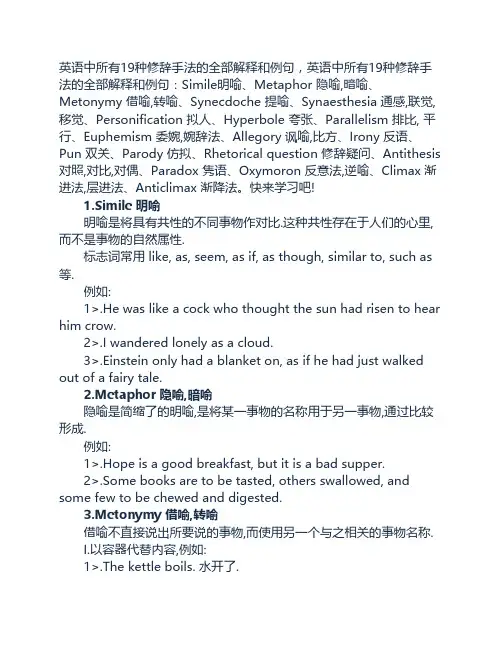
英语中所有19种修辞手法的全部解释和例句,英语中所有19种修辞手法的全部解释和例句:Simile明喻、Metaphor 隐喻,暗喻、Metonymy 借喻,转喻、Synecdoche 提喻、Synaesthesia 通感,联觉,移觉、Personification 拟人、Hyperbole 夸张、Parallelism 排比, 平行、Euphemism 委婉,婉辞法、Allegory 讽喻,比方、Irony 反语、Pun 双关、Parody 仿拟、Rhetorical question 修辞疑问、Antithesis 对照,对比,对偶、Paradox 隽语、Oxymoron 反意法,逆喻、Climax 渐进法,层进法、Anticlimax 渐降法。
快来学习吧! 1.Simile 明喻 明喻是将具有共性的不同事物作对比.这种共性存在于人们的心里,而不是事物的自然属性. 标志词常用 like, as, seem, as if, as though, similar to, such as 等. 例如: 1>.He was like a cock who thought the sun had risen to hear him crow. 2>.I wandered lonely as a cloud. 3>.Einstein only had a blanket on, as if he had just walked out of a fairy tale. 2.Metaphor 隐喻,暗喻 隐喻是简缩了的明喻,是将某一事物的名称用于另一事物,通过比较形成. 例如: 1>.Hope is a good breakfast, but it is a bad supper. 2>.Some books are to be tasted, others swallowed, and some few to be chewed and digested. 3.Metonymy 借喻,转喻 借喻不直接说出所要说的事物,而使用另一个与之相关的事物名称. I.以容器代替内容,例如: 1>.The kettle boils. 水开了. 2>.The room sat silent. 全屋人安静地坐着. II.以资料.工具代替事物的名称,例如: Lend me your ears, please. 请听我说. III.以作者代替作品,例如: a complete Shakespeare 莎士比亚全集 VI.以具体事物代替抽象概念,例如: I had the muscle, and they made money out of it. 我有力气,他们就用我的力气赚钱. 4.Synecdoche 提喻 提喻用部分代替全体,或用全体代替部分,或特殊代替一般. 例如: 1>.There are about 100 hands working in his factory.(部分代整体) 他的厂里约有100名工人. 2>.He is the Newton of this century.(特殊代一般) 他是本世纪的牛顿. 3>.The fox goes very well with your cap.(整体代部分) 这狐皮围脖与你的帽子很相配. 5.Synaesthesia 通感,联觉,移觉 这种修辞法是以视.听.触.嗅.味等感觉直接描写事物.通感就是把不同感官的感觉沟通起来,借联想引起感觉转移,“以感觉写感觉”。
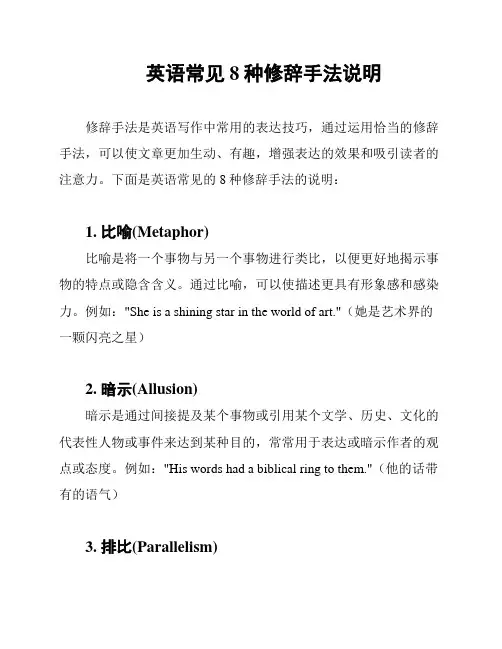
英语常见8种修辞手法说明修辞手法是英语写作中常用的表达技巧,通过运用恰当的修辞手法,可以使文章更加生动、有趣,增强表达的效果和吸引读者的注意力。
下面是英语常见的8种修辞手法的说明:1. 比喻(Metaphor)比喻是将一个事物与另一个事物进行类比,以便更好地揭示事物的特点或隐含含义。
通过比喻,可以使描述更具有形象感和感染力。
例如:"She is a shining star in the world of art."(她是艺术界的一颗闪亮之星)2. 暗示(Allusion)暗示是通过间接提及某个事物或引用某个文学、历史、文化的代表性人物或事件来达到某种目的,常常用于表达或暗示作者的观点或态度。
例如:"His words had a biblical ring to them."(他的话带有的语气)3. 排比(Parallelism)排比是通过重复使用类似的词、短语或句子结构,使文章的句子齐整有序,增强表达的力度和冲击力。
例如:"We came, we saw, we conquered." (我们来了,我们看到了,我们战胜了)4. 反问(Rhetorical Question)反问是在文章或演讲中提出一个问题,但并不期待对方回答,而是用问句来引导读者或听众思考某个问题或强调某个观点。
例如:"Isn't it a beautiful day?"(今天是不是个美好的一天呢?)5. 夸张(Hyperbole)夸张是通过夸大的描述方式来强调某个事物或情感,以达到增强效果的目的。
夸张常用于幽默、夸张或强调的场合。
例如:"I've told you a million times."(我已经告诉过你一百万次了)比较是通过将两个或多个事物进行对比,以突出它们的差异或相似之处,使表达更具有说服力和可信度。
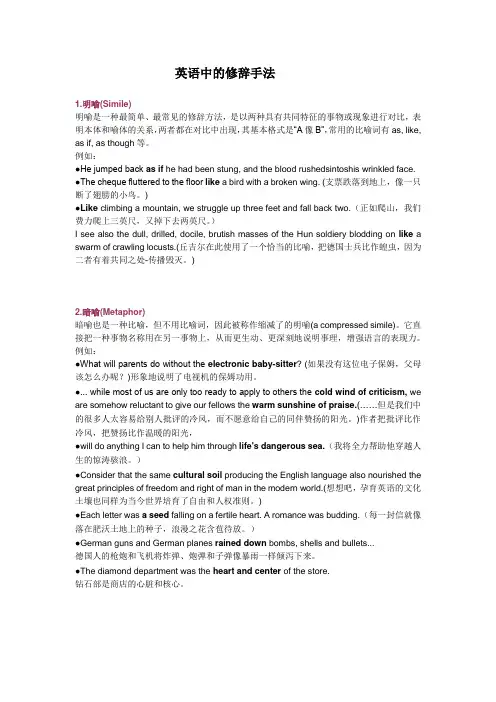
英语中的修辞手法1.明喻(Simile)明喻是一种最简单、最常见的修辞方法,是以两种具有共同特征的事物或现象进行对比,表明本体和喻体的关系,两者都在对比中出现,其基本格式是“A像B”,常用的比喻词有as, like, as if, as though等。
例如:●He jumped back as if he had been stung, and the blood rushedsintoshis wrinkled face.●The cheque fluttered to the floor like a bird with a broken wing. (支票跌落到地上,像一只断了翅膀的小鸟。
)●Like climbing a mountain, we struggle up three feet and fall back two.(正如爬山,我们费力爬上三英尺,又掉下去两英尺。
)I see also the dull, drilled, docile, brutish masses of the Hun soldiery blodding on like a swarm of crawling locusts.(丘吉尔在此使用了一个恰当的比喻,把德国士兵比作蝗虫,因为二者有着共同之处-传播毁灭。
)2.暗喻(Metaphor)暗喻也是一种比喻,但不用比喻词,因此被称作缩减了的明喻(a compressed simile)。
它直接把一种事物名称用在另一事物上,从而更生动、更深刻地说明事理,增强语言的表现力。
例如:●What will parents do without the electronic baby-sitter? (如果没有这位电子保姆,父母该怎么办呢?)形象地说明了电视机的保姆功用。
●... while most of us are only too ready to apply to others the cold wind of criticism, we are somehow reluctant to give our fellows the warm sunshine of praise.(……但是我们中的很多人太容易给别人批评的冷风,而不愿意给自己的同伴赞扬的阳光。
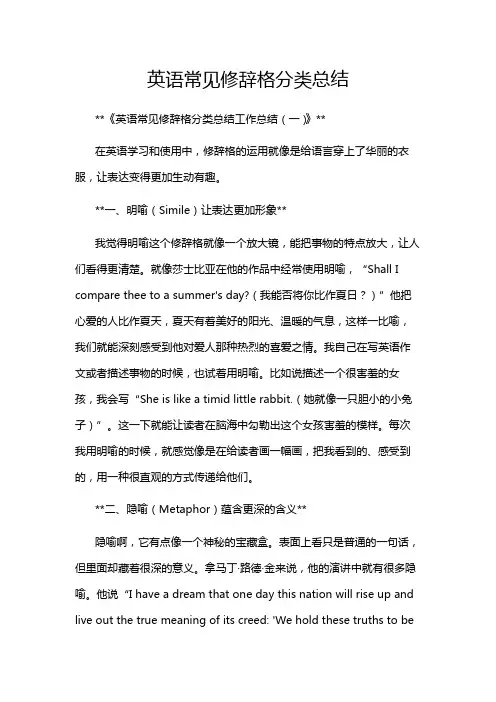
英语常见修辞格分类总结**《英语常见修辞格分类总结工作总结(一)》**在英语学习和使用中,修辞格的运用就像是给语言穿上了华丽的衣服,让表达变得更加生动有趣。
**一、明喻(Simile)让表达更加形象**我觉得明喻这个修辞格就像一个放大镜,能把事物的特点放大,让人们看得更清楚。
就像莎士比亚在他的作品中经常使用明喻,“Shall I compare thee to a summer's day?(我能否将你比作夏日?)”他把心爱的人比作夏天,夏天有着美好的阳光、温暖的气息,这样一比喻,我们就能深刻感受到他对爱人那种热烈的喜爱之情。
我自己在写英语作文或者描述事物的时候,也试着用明喻。
比如说描述一个很害羞的女孩,我会写“S he is like a timid little rabbit.(她就像一只胆小的小兔子)”。
这一下就能让读者在脑海中勾勒出这个女孩害羞的模样。
每次我用明喻的时候,就感觉像是在给读者画一幅画,把我看到的、感受到的,用一种很直观的方式传递给他们。
**二、隐喻(Metaphor)蕴含更深的含义**隐喻啊,它有点像一个神秘的宝藏盒。
表面上看只是普通的一句话,但里面却藏着很深的意义。
拿马丁·路德·金来说,他的演讲中就有很多隐喻。
他说“I have a dream that one da y this nation will rise up and live out the true meaning of its creed: 'We hold these truths to beself - evident, that all men are created equal.'(我有一个梦想,有一天这个国家会站起来,实现其信条的真正含义:我们认为这些真理是不言而喻的,即人人生而平等。
)”这里把美国这个国家的发展隐喻为一个人的“站起来”,暗示着国家走向平等和正义。
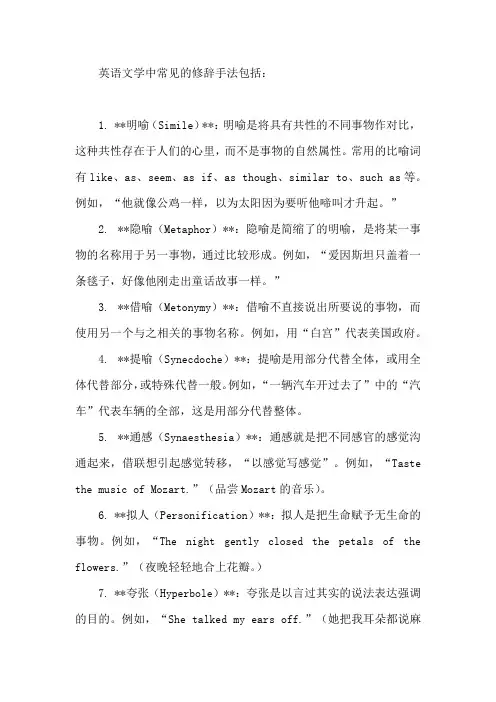
英语文学中常见的修辞手法包括:1. **明喻(Simile)**:明喻是将具有共性的不同事物作对比,这种共性存在于人们的心里,而不是事物的自然属性。
常用的比喻词有like、as、seem、as if、as though、similar to、such as等。
例如,“他就像公鸡一样,以为太阳因为要听他啼叫才升起。
”2. **隐喻(Metaphor)**:隐喻是简缩了的明喻,是将某一事物的名称用于另一事物,通过比较形成。
例如,“爱因斯坦只盖着一条毯子,好像他刚走出童话故事一样。
”3. **借喻(Metonymy)**:借喻不直接说出所要说的事物,而使用另一个与之相关的事物名称。
例如,用“白宫”代表美国政府。
4. **提喻(Synecdoche)**:提喻是用部分代替全体,或用全体代替部分,或特殊代替一般。
例如,“一辆汽车开过去了”中的“汽车”代表车辆的全部,这是用部分代替整体。
5. **通感(Synaesthesia)**:通感就是把不同感官的感觉沟通起来,借联想引起感觉转移,“以感觉写感觉”。
例如,“Taste the music of Mozart.”(品尝Mozart的音乐)。
6. **拟人(Personification)**:拟人是把生命赋予无生命的事物。
例如,“The night gently closed the petals of the flowers.”(夜晚轻轻地合上花瓣。
)7. **夸张(Hyperbole)**:夸张是以言过其实的说法表达强调的目的。
例如,“She talked my ears off.”(她把我耳朵都说麻了。
)这些修辞手法在英语文学中被广泛使用,可以帮助作者更生动、形象地表达自己的想法和感受。
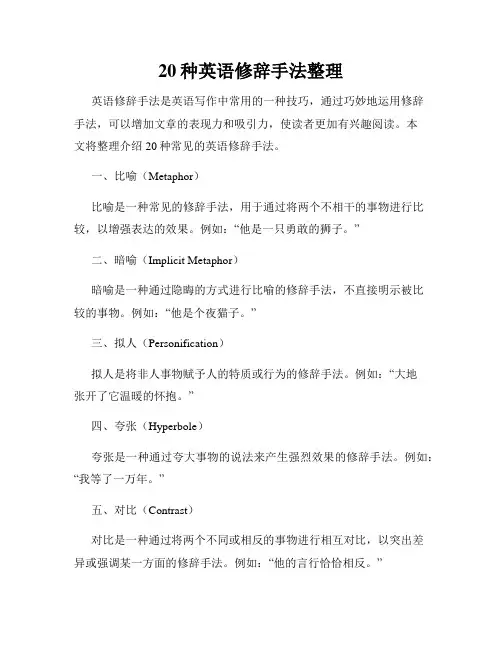
20种英语修辞手法整理英语修辞手法是英语写作中常用的一种技巧,通过巧妙地运用修辞手法,可以增加文章的表现力和吸引力,使读者更加有兴趣阅读。
本文将整理介绍20种常见的英语修辞手法。
一、比喻(Metaphor)比喻是一种常见的修辞手法,用于通过将两个不相干的事物进行比较,以增强表达的效果。
例如:“他是一只勇敢的狮子。
”二、暗喻(Implicit Metaphor)暗喻是一种通过隐晦的方式进行比喻的修辞手法,不直接明示被比较的事物。
例如:“他是个夜猫子。
”三、拟人(Personification)拟人是将非人事物赋予人的特质或行为的修辞手法。
例如:“大地张开了它温暖的怀抱。
”四、夸张(Hyperbole)夸张是一种通过夸大事物的说法来产生强烈效果的修辞手法。
例如:“我等了一万年。
”五、对比(Contrast)对比是一种通过将两个不同或相反的事物进行相互对比,以突出差异或强调某一方面的修辞手法。
例如:“他的言行恰恰相反。
”六、排比(Parallelism)排比是一种通过对句子或短语进行平行结构的修辞手法,以强调重点或增加语句的节奏感。
例如:“奋斗,拼搏,追求,努力。
”七、倒装(Inversion)倒装是一种颠倒语序的修辞手法,常常用于疑问句或为了强调某一部分。
例如:“Never have I seen such a beautiful sunset.”八、反问(Rhetorical Question)反问是一种用疑问句的形式表达肯定或否定的修辞手法,常用于强调某一观点或引起读者思考。
例如:“难道你不想成功吗?”九、比较(Comparison)比较是通过将两个事物进行对比,以凸显共同点或差异的修辞手法。
例如:“学习就像是爬山,充满了艰辛和挑战。
”十、设问(Hypophora)设问是一种在文章中提出问题,并在下文中进行回答的修辞手法,常用于引起读者的关注和思考。
例如:“你知道成功的秘诀是什么吗?答案很简单——努力。
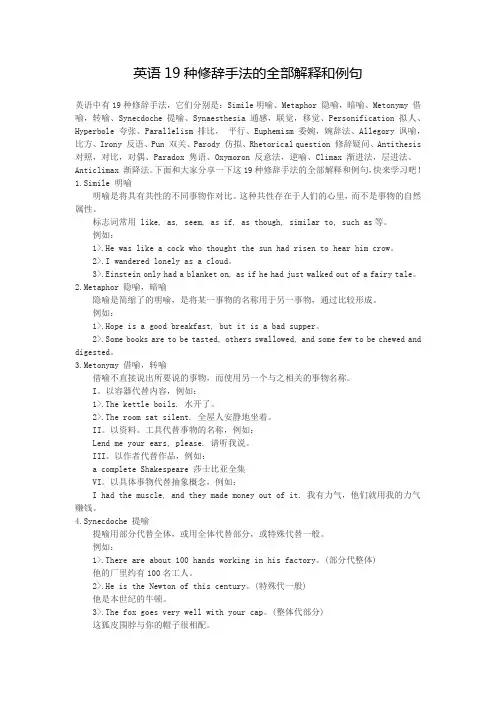
英语19种修辞手法的全部解释和例句英语中有19种修辞手法,它们分别是:Simile明喻、Metaphor 隐喻,暗喻、Metonymy 借喻,转喻、Synecdoche 提喻、Synaesthesia 通感,联觉,移觉、Personification 拟人、Hyperbole 夸张、Parallelism 排比,平行、Euphemism 委婉,婉辞法、Allegory 讽喻,比方、Irony 反语、Pun 双关、Parody 仿拟、Rhetorical question 修辞疑问、Antithesis 对照,对比,对偶、Paradox 隽语、Oxymoron 反意法,逆喻、Climax 渐进法,层进法、Anticlimax 渐降法。
下面和大家分享一下这19种修辞手法的全部解释和例句,快来学习吧!1.Simile 明喻明喻是将具有共性的不同事物作对比。
这种共性存在于人们的心里,而不是事物的自然属性。
标志词常用 like, as, seem, as if, as though, similar to, such as等。
例如:1>.He was like a cock who thought the sun had risen to hear him crow。
2>.I wandered lonely as a cloud。
3>.Einstein only had a blanket on, as if he had just walked out of a fairy tale。
2.Metaphor 隐喻,暗喻隐喻是简缩了的明喻,是将某一事物的名称用于另一事物,通过比较形成。
例如:1>.Hope is a good breakfast, but it is a bad supper。
2>.Some books are to be tasted, others swallowed, and some few to be chewed and digested。
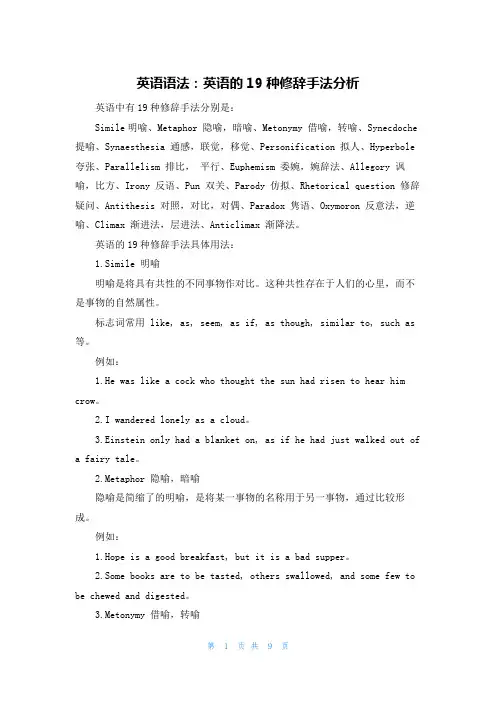
英语语法:英语的19种修辞手法分析英语中有19种修辞手法分别是:Simile明喻、Metaphor 隐喻,暗喻、Metonymy 借喻,转喻、Synecdoche 提喻、Synaesthesia 通感,联觉,移觉、Personification 拟人、Hyperbole 夸张、Parallelism 排比,平行、Euphemism 委婉,婉辞法、Allegory 讽喻,比方、Irony 反语、Pun 双关、Parody 仿拟、Rhetorical question 修辞疑问、Antithesis 对照,对比,对偶、Paradox 隽语、Oxymoron 反意法,逆喻、Climax 渐进法,层进法、Anticlimax 渐降法。
英语的19种修辞手法具体用法:1.Simile 明喻明喻是将具有共性的不同事物作对比。
这种共性存在于人们的心里,而不是事物的自然属性。
标志词常用 like, as, seem, as if, as though, similar to, such as 等。
例如:1.He was like a cock who thought the sun had risen to hear him crow。
2.I wandered lonely as a cloud。
3.Einstein only had a blanket on, as if he had just walked out ofa fairy tale。
2.Metaphor 隐喻,暗喻隐喻是简缩了的明喻,是将某一事物的名称用于另一事物,通过比较形成。
例如:1.Hope is a good breakfast, but it is a bad supper。
2.Some books are to be tasted, others swallowed, and some few to be chewed and digested。
英文中的修辞手法英文中有许多修辞手法,这些手法通过运用特定的语言技巧,可以增强文学作品的表达力和感染力。
以下是一些常见的英文修辞手法:比喻(Metaphor):将两个不同的事物进行比较,以强调它们之间的相似之处,而不使用"like"或"as"。
例如:“时间是一把无情的剑。
”拟人(Personification):赋予非人物以人的特质或行为,使其更具生动性。
例如:“风儿轻轻地低语。
”象征(Symbolism):使用一个事物、符号或象征来代表另一个抽象概念。
例如:“燕子在文学中通常象征着春天和希望。
”暗喻(Metonymy):用一个与所指实体有着密切关联的词汇来替代它。
例如:“白宫发布了一份声明”中的“白宫”代表美国政府。
排比(Parallelism):通过使用相似的句式或结构,强调语言的平衡和韵律。
例如:“我不怕困难,我不怕失败,我不怕挑战。
”双关语(Pun):利用一个词汇项的多义性或相似的发音来制造幽默或引起思考。
例如:“时间飞逝,果然很‘秒’。
”讽刺(Irony):通过言辞上的反讽,表达与字面意义相反的意思。
例如:“这个‘伟大’的计划居然失败了。
”悬念(Suspense):通过保持某种信息的不明确,刺激读者的兴趣,以激发紧张感。
例如:“她打开门,里面的一切都让她惊呆了。
”对仗(Antithesis):将相对或对立的思想或概念通过并列的结构进行强调。
例如:“昨夜寒风凛冽,今朝暖阳明媚。
”比较(Simile):将两个事物通过使用"like"或"as"进行比较,以突显它们之间的相似之处。
例如:“她如同一朵盛开的花。
”这些修辞手法可以单独使用,也可以结合在一起,创造出更为复杂和富有表现力的文学效果。
作家通常根据他们的写作目的,选择最适合表达自己意图的修辞手法。
高级英语1修辞手法汇总修辞手法是英语写作中常用的一种技巧,通过运用修辞手法可以使文章更加生动、富有表现力,增强读者的阅读体验。
在高级英语写作中,修辞手法的运用尤为重要,它可以为文章赋予深度和风格,并提升文章的艺术性和说服力。
下面将介绍几种常见的修辞手法。
一、比喻(Metaphor)比喻是一种通过将一个事物与另一个事物相比较,以便更好地说明或形容某个概念或主题的修辞手法。
它常常用于描述抽象的概念,使之变得更加具体和形象。
例句:1. He is a lion in the battlefield.2. Her smile was a ray of sunshine on a cloudy day.二、拟人(Personification)拟人是一种将非人类的事物或抽象的概念赋予人类的特征和行为的修辞手法。
通过将这些非人类的事物拟人化,可以使文章更生动有趣,增强读者对其中事物的感知和理解。
例句:1. The wind whispered through the trees.2. The flowers danced in the breeze.三、夸张(Hyperbole)夸张是一种通过夸大事物的特征或情况来强调其重要性或影响力的修辞手法。
它常用于诗歌、演讲或幽默作品中,以引起读者的兴趣和共鸣。
例句:1. I've told you a million times not to do that!2. The line for the new iPhone was a mile long.四、反问(Rhetorical question)反问是一种不需要回答的问题,用于引起读者的思考或表达某种意义的修辞手法。
通过将一个问题直接提出,可以引起读者的兴趣和注意,并激发其对文章主题的思考。
例句:1. Do you really think I would believe such a ridiculous story?2. Can you imagine a world without music?五、排比(Parallelism)排比是一种通过重复并列的结构或类似的语法结构来增加修辞效果的修辞手法。
英语中常用的修辞手法英语中常用的修辞手法有以下几种:1. Simile(明喻):通过使用“like”或“as”等词将两个不同的事物进行比较,以突出它们的相似之处。
Example: Her eyes were like stars in the night sky.2. Metaphor(隐喻):将一个事物直接比作另一个事物,而不使用“like”或“as”等词。
Example: Life is a journey.3. Personification(拟人):赋予无生命的事物以人类的特征或行为。
Example: The wind whispered through the trees.4. Hyperbole(夸张):故意夸大或夸张某个事物的特征或程度。
Example: I could sleep for a year.5. Parallelism(排比):使用相同或相似的结构、语法或词汇来表达一个想法或主题。
Example: She is smart, talented, and beautiful.6. Alliteration(头韵):重复相同的声音或字母,以增强语言的韵律和节奏。
Example: The quick brown fox jumps over the lazy dog.7. Onomatopoeia(拟声):使用与所描述的声音相似的词汇来模拟声音。
Example: The clock tick-tocked in the quiet room.8. Repetition(重复):重复某个词汇或短语以增强语言的效果。
Example: Once upon a time, there was a princess who lived in a castle.9. Antithesis(对比):将两个相反的想法或概念放在一起进行对比。
Example: Love is an act of endless forgiveness, a tender look which becomes a habit.这些修辞手法可以帮助作者更生动、形象地表达自己的意思,增强语言的感染力和说服力。
英语修辞手法英语定义修辞手法是英语写作中经常使用的一种技巧,通过运用一定的语法和词汇结构,以达到增强文章表达力、形象生动、感染读者等效果的目的。
本文将介绍英语修辞手法的定义以及常见的几种修辞手法。
一、英语修辞手法的定义英语修辞手法指的是通过特定的词语、句式或修辞手段来增加语言的表现力,使文章更具吸引力和感染力。
它们能够帮助作者传达更准确、更具有感染力的信息,同时也能够使读者更容易理解和接受这些信息。
英语修辞手法涉及词法、语法和修辞三个方面,常常用于文学作品、演讲和广告等多种语境中。
二、常见的英语修辞手法1. 比喻(Metaphor)比喻是将一个物体或概念与另一个不相关的物体或概念进行类比,以突出某种特性或表达某种意义。
比如:“他是个太阳,照亮了我生活的每个角落。
”其中“太阳”是比喻,用来形容他的光芒和温暖。
2. 拟人(Personification)拟人是将非人类的事物赋予人的特点和行为,使其更生动有趣。
例如:“时间像一只无形的鸟,轻轻地飞过。
”其中时间被拟人化为一只飞鸟。
3. 反问(Rhetorical Question)反问是提出一个问题,但并不期望得到回答,而是用来强调观点或引起读者的思考。
例如:“你难道不希望自己过上幸福快乐的生活吗?”这个反问句用来表达作者的期待和呼吁。
4. 排比(Parallelism)排比是将多个相同或相似的句式结构或词语进行并列排列,以增加语言的节奏感和修辞效果。
比如:“春风送暖,夏日炎炎,秋叶飘落,冬雪皑皑。
”这个句子中的排比使用了相似的句式和词语,使得句子更流畅、有韵律感。
5. 夸张(Hyperbole)夸张是为了强调某个事物或情感,故意夸大其表达,以产生强烈的效果。
例如:“我饿得可以吞下一头大象!”这句话用夸张的方式表达了饥饿的感受。
6. 反复(Repetition)反复是指有意词语或句子的重复出现,以加强表达力和引起读者的共鸣。
例如:“Never give up, never give in.”这种反复使用相同词语的表达方式,可以使观点更加坚定和有力。
英语修辞手法总结归纳英语修辞手法总结归纳:明喻、转喻、提喻、隐喻、拟人、拟声、夸张、双关、讽刺、联觉、头韵、委婉、修辞反问、隽语、对照、渐进法、渐降法、引用、叠言、仿拟、排比、寓言。
一、明喻(Simile)是以两种具有相同特征的事物和现象进行对比,表明本体和喻体之间的相似关系,两者都在对比中出现。
常用比喻词like, as, as if, as though,seem,similar to, such as等,Eg:1. This elephant is like a snake as anybody can see.这头象和任何人见到的一样像一条蛇。
二、隐喻(Metaphor)这种比喻不通过比喻词进行,而是直接将用事物当作乙事物来描写,甲乙两事物之间的联系和相似之处是暗含的。
Eg:1、He is a pig.他简直是头猪。
(比喻:他是一个像猪一般的人,指肮脏,贪吃的人。
)三、提喻(Synecdoche)提喻大致归纳为四种情况:a.部分和全体互代;b.以材料代替事物;c.抽象和具体互代;d.以个体代替整个类。
Eg:1. Have you any coppers? 你有钱吗?(以材料代事物,即以copper铜喻指coin money铜币)四、拟人(Personification)这种修辞方法是把人类的特点、特性加于外界事物之上,使之人格化,以物拟人,以达到彼此交融,合二为一。
拟人是把生命赋予无生命的事物.Eg:I was very happy and could hear the birds singing in the woods.(把鸟拟人化)我很高兴,也能听到鸟儿在树林里唱歌。
五、夸张(Hyperbole)这是运用丰富的想象,过激的言词,渲染和装饰客观事物,以达到强调的效果,也就是夸张化。
Eg:1.My blood froze.我的血液都凝固了。
六、转喻(Metonymy)是指当甲事物同乙事物不相类似,但有密切关系时,可以利用这种关系,以乙事物的名称来取代甲事物,这样的一种修辞手段。
1. 比喻(metaphor)比喻就是打比方。
可分为明喻和暗喻:明喻(simile):A figure of speech in which two essentially unlike things are compared. 明喻:一种修辞手法,把两种基本不相像的东西进行比较.用like, as, as...as, as if(though) 或用其他词语指出两个不同事物的相似之处。
例如:“How like the winter hath my absence been”or “So are you to my thoughts as food to life” (Shakespeare). 如“我的离开好象是冬天来临” 或“你对我的思想就象食物对于生命一样重要” (莎士比亚)O my love's like a red, red rose. 我的爱人像一朵红红的玫瑰花。
The man can't be trusted. He is as slippery as an eel. 那个人不可信赖。
他像鳗鱼一样狡猾。
He jumped as if he had been stung.他像被蜇了似的跳了起来。
Childhood is like a swiftly passing dream. 童年就像一场疾逝的梦。
暗喻(metaphor):缩写met.,metaph. A figure of speech in which a word or phrase that ordinarily designates one thing is used to designate another, thus making an implicit comparison.用一个词来指代与该词所指事物有相似特点的另外一个事物。
例如:He has a heart of stone. 他有一颗铁石心肠。
矿产资源开发利用方案编写内容要求及审查大纲
矿产资源开发利用方案编写内容要求及《矿产资源开发利用方案》审查大纲一、概述
㈠矿区位置、隶属关系和企业性质。
如为改扩建矿山, 应说明矿山现状、
特点及存在的主要问题。
㈡编制依据
(1简述项目前期工作进展情况及与有关方面对项目的意向性协议情况。
(2 列出开发利用方案编制所依据的主要基础性资料的名称。
如经储量管理部门认定的矿区地质勘探报告、选矿试验报告、加工利用试验报告、工程地质初评资料、矿区水文资料和供水资料等。
对改、扩建矿山应有生产实际资料, 如矿山总平面现状图、矿床开拓系统图、采场现状图和主要采选设备清单等。
二、矿产品需求现状和预测
㈠该矿产在国内需求情况和市场供应情况
1、矿产品现状及加工利用趋向。
2、国内近、远期的需求量及主要销向预测。
㈡产品价格分析
1、国内矿产品价格现状。
2、矿产品价格稳定性及变化趋势。
三、矿产资源概况
㈠矿区总体概况
1、矿区总体规划情况。
2、矿区矿产资源概况。
3、该设计与矿区总体开发的关系。
㈡该设计项目的资源概况
1、矿床地质及构造特征。
2、矿床开采技术条件及水文地质条件。